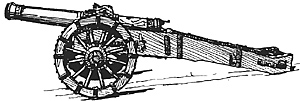 This short piece provides, I hope, an underpinning for future articles on each of the four artillery regiments which served in the U.S. forces during the War of 1812.
This short piece provides, I hope, an underpinning for future articles on each of the four artillery regiments which served in the U.S. forces during the War of 1812.
The United States began the war with a veritable smorgasbord of artillery guns, equipment, and units. It can not be said with any certainty that any two artillery companies began the war with identical sets of guns, either numbers, size, or composition. Guns of various sizes, made of bronze or iron, on differing carriages were scattered around the country in coastal fortifications or frontier forts. There were also many artillery companies serving as infantry and virtually untrained as gun crews.
This is not to say that efforts had not been made to standardize the two branches of artillery: the three regiments of artillery and the single regiment of light artillery. While the federal government owned hundreds of guns, many from the days of the Revolution, they varied in size. Secretary of War Henry Dearborn (1801-1809) standardized field guns as iron six-pounders. Bronze was less brittle and therefore tended not to burst as frequently as iron guns but iron was cheaper and at that time, copper was somewhat scarce in America.
Likewise, carriages and limbers were standardized to a modified Gribeauval system although scores of non-standard carriages, caissons, and limbers would remain in service throughout the war. In a somewhat odd arrangement, the government made its own carriages and caissons but bought the guns from any of the hundreds of foundries springing up in the new country. Of course, the individual states also maintained artillery companies in the militia establishment and in volunteer companies but that is beyond the scope of this paper.
In the beginning of the war, the companies of the Regiment of Light Artillery were all serving as infantry. The companies of the three artillery regiments were serving their guns or as infantry in forts and fortifications along the periphery of the country. The light artillery was considered a separate branch that would never serve guns in coastal fortifications while the other artillery regiments could serve as foot artillery, coastal artillery, or infantry. Remember that many companies were still recruiting and mustering in at their rendezvous cities. Because it was easier to do, it was these newly-raised companies that were outfitted and sent to the armies in the field, and not the older, possibly better trained units, that were already serving on the coast or frontier. This explains why the companies of the veteran First Regiment hardly fired a shot in anger until later in the war.
In June, two companies of light artillery were each issued four guns and the necessary limbers and horses and sent to the Niagara. These companies supported the ill-fated attack on Queenston from the American shore. Later in the year, three more companies were outfitted and sent to Plattsburgh to join Dearbornís army forming there. They went along on Dearbornís abortive November offensive before returning to winter quarters. In 1813, with more companies fielded, attempts were made to limit the guns to any single company to two calibers, thus easing logistical problems. For example, a division of artillery (the name used to denote a company armed with guns as opposed to an artillery company serving as infantry) might have four six-ponders and two 5.5-inch howitzers. However, the army never quite got around to enacting this logical and common-sense reform because shipping guns around to other locations was costly in the extreme.
Early in 1814, Congress attempted, unsuccessfully, to promote unity within the artillery. Because the First regiment was a peacetime, permanent unit and the Second and Third Regiments were formed for the duration of the war, officer promotions were handled quite differently between the two, officers of the first having much more potential for promotion. Therefore Congress consolidated the three regiments into a single Corps of Artillery which consisted of twelve battalions of four companies each.
Back to Table of Contents -- War of 1812 #3
Back to War of 1812 List of Issues
Back to MagWeb Magazine List
© Copyright 2002 by Rich Barbuto.
This article appears in MagWeb (Magazine Web) on the Internet World Wide Web.
Other military history articles and gaming articles are available at http://www.magweb.com